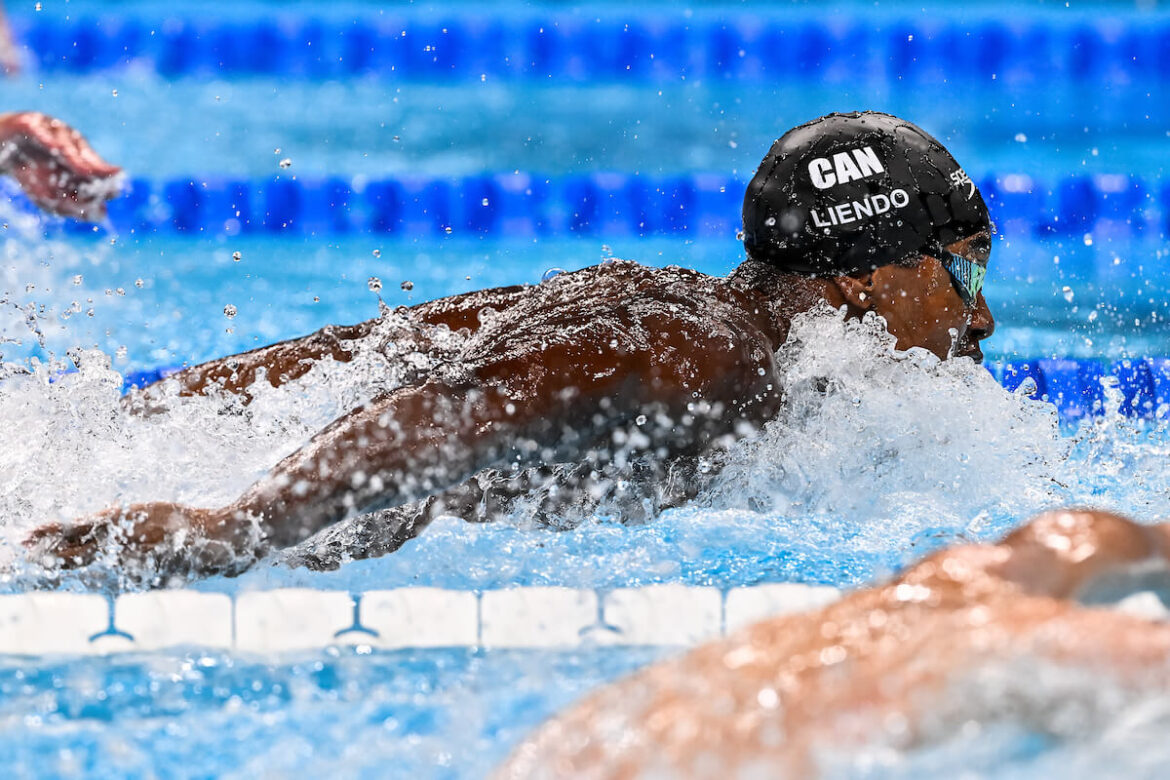How the World Cup Stop in Toronto Reflected Growth of Canadian Swimming
Mary-Sophie Harvey thought she knew what to expect. After three weeks of challenging racing while participating in the World Aquatics World Cup, the stands seemed rather empty when the Canadian entered the ready room for the final of the 100-meter butterfly in Toronto. It seemed like it would be a muted atmosphere for the race, as small cheers echoed through the natatorium. That is, until Harvey stepped out.
“The crowd went absolutely wild. You could hear the screams,” Harvey said. “It’s something I’ll remember vividly.”
The noise from the home fans was unrelenting throughout the weekend, and they were given an incredible show. Team Canada secured five gold medals and 10 total medals, finishing second only to the United States during the Toronto stop. It was a strong statement for the Canadians, emblematic of the growth their program has experienced in recent years.
“We’re at the peak of the growth of the sport right now,” said Finlay Knox, who won gold in the 200 individual medley at the 2024 World Championships in Doha. “It’s incredibly exciting.”
Over three days of racing in Toronto, the Canadian team encapsulated a country-wide swimming movement, one pre-race roar at a time.
Making Waves
For years, the Canadian National Team has gradually built a strong foundation for success. It makes it hard to remember that the team was once a non-factor internationally, with just one Olympic medal won from 1988-2012. That is, until one special week in Rio De Janeiro. At the 2016 Games, the Canadian women took charge, earning six medals in a historic performance for the country. It was a moment that put the whole region on notice.
“The 2016 women’s team really set the precedent,” Knox said. “The more people we have doing this at a high level, the more that come following in their footsteps.”
That inspiration is reflected in the current team, and its growing talent. Young stars like Josh Liendo and Summer McIntosh are certainly the headliners, with Liendo putting together an incredible weekend in Toronto. As Harvey pointed out, the expectations team-wide have become higher than ever before.
“We have star swimmers, but all of us also want to make finals, and make podiums, and inspire each other to do so,” Harvey said.
The team certainly accomplished that goal at its home World Cup stop. Fourteen Canadians reached finals in Toronto, while nine athletes reached the podium.
“We’re pushing each other to get better,” Harvey said. “It’s something we want to make a habit of, and replicate in Los Angeles.”
There’s No Place Like Home
With the success of the Canadian team, the sport has experienced a surge of support country-wide. According to the Toronto Star, funding increased significantly for Olympic swimming from the 2012-2020. The team received $11 million from the high-performance funding program, Own The Podium, for the London Games, and $22 million for the 2020 Games in Tokyo. What was once a struggling Olympic sport has developed significantly, evidenced by crowds like the one in Toronto.
“We were all joking and saying, ‘We’re saving up for Toronto,’” Harvey said, referencing the move of the World Cup circuit from two legs in the United States to Toronto. “When we have Olympic Trials and meets like that, people are generally cheering for an individual. But for them to be cheering so loudly for Canada as a whole, it made it so much better.”
Even with the recent success, there is room to grow. A recent study by Canadian research company The Strategic Council identified swimming as the “most popular organized sport or physical activity” among young children in the country.
“The more people we have at this high level, the more that inspires kids to follow in our footsteps, “ Knox said. “We’re at the peak of the growth of the sport right now, and it’s very exciting.”
The growth is incredibly exciting for the athletes, and motivation is at a high, with team members serving as role models for a generation. However, it’s a relationship which Harvey believes is motivating for all parties involved, comparing it to her relationship with McIntosh.
“When I see Summer standing on the podium, it’s like, ‘I want to be there, too.’ It’s quite inspiring,” said Harvey. “We push each other to get better, and I know it’s the same for many Canadian swimmers, which is very exciting.”
“Teamwork Makes The Dream Work”
The experience in Toronto was a spectacle, and a fantastic showing for the athletes. But in their eyes, this is just the beginning. Harvey explained that the team has its eyes set on the U.S Open in December, as well as the Pan Pacific Championships next summer in Irvine, California.
Even with their sights set toward the future, both athletes were quick to emphasize the value of the weekend. They felt the team benefited mightily from having time together to bond. Knox took it as an opportunity to learn more about his teammates’ preparation.
“Some people need to be laid back and others need to be more dialed in (for the meet), and so getting to know each other helps strengthen our relationships, and therefore our results in the pool,” Knox said.
Harvey called it a “more unified” culture than she experienced during her early years with the team.
“It used to be a bit scary, like ‘I don’t know if I can talk to this person,’” Harvey said. “Now, everyone is close together and really present for every single athlete.”
More talented, better supported and perhaps increasingly unified, the Canadians should be a threat on the international stage for years to come.
“It’s going to be exciting to see where we can push this sport, and how fast our potential is,” Knox said.
